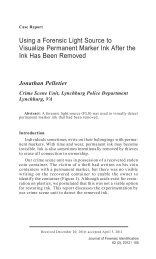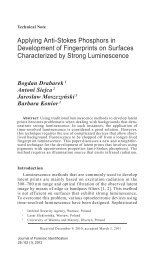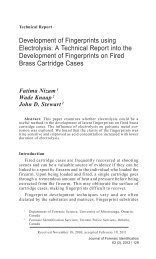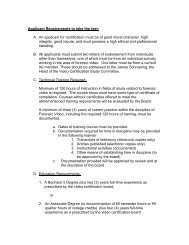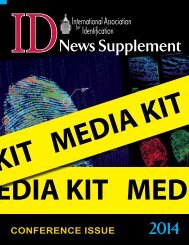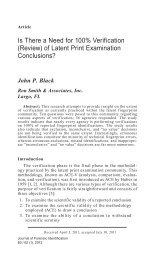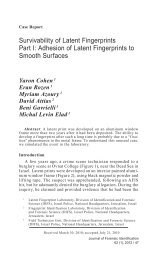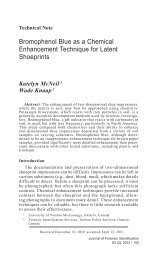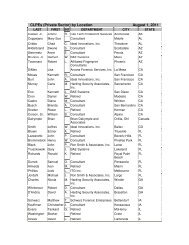Individualization Using Friction Skin Impressions: Scientifically ...
Individualization Using Friction Skin Impressions: Scientifically ...
Individualization Using Friction Skin Impressions: Scientifically ...
Create successful ePaper yourself
Turn your PDF publications into a flip-book with our unique Google optimized e-Paper software.
Interpretation of Uniqueness<br />
The critics continue to argue that even if uniqueness existed<br />
(noting that it has not been proven in the most absolute sense,<br />
but while making this logically invalid claim are rejecting the<br />
opinions of the general scientific community established by the<br />
NAS), we currently do not have the ability or tools to detect such<br />
uniqueness because it exists only in a metaphysical or rhetorical<br />
sense, that is, no “discernable uniqueness” [6, 8, 10]. In theory,<br />
this argument would carry some merit for discussion should the<br />
uniqueness of friction ridge skin only be observed at the cellular<br />
or molecular level; however, medical and empirical research<br />
has shown that the uniqueness of friction ridge skin pertains<br />
to the individual ridge delineation and characteristics observable<br />
at the macroscopic level [2, 30] and thus is well within the<br />
range of detection by the human observer, depending upon the<br />
quality of the impression. Latent print examiners typically rely<br />
on three levels of detail as described by Ashbaugh to quantitatively<br />
measure the clarity of the impression [30] and the<br />
ability to distinguish the unique characteristics. Level 1 detail<br />
describes the examiner’s ability to discern the overall pattern<br />
and aggregate ridge f low. Level 1 detail occurs in disproportionate<br />
amounts within the population according to statistical<br />
studies of the frequency of pattern types [31, 32]; however,<br />
individualizations cannot be effected solely on Level 1 detail<br />
because it is genetically influenced and shared by more than one<br />
individual. Level 2 detail, which is epigenetically influenced,<br />
describes the examiner’s ability to discern the individual ridge<br />
paths and ridge characteristics. And Level 3 detail, which is also<br />
epigenetically inf luenced, describes the examiner’s ability to<br />
discern the individual ridge unit shapes and pores. Levels 2 and<br />
3 detail define the characteristics that are unique to friction skin,<br />
and thus individualization conclusions can be logically deduced<br />
using the information from these levels [30]. Therefore, it is the<br />
quality of the impression that dictates the examiner’s ability<br />
to detect the individual characteristics and it is the quantity<br />
of those detected characteristics, when considered according<br />
to their location, orientation, and relative spatial relationship<br />
amongst one another, that enable the use of friction ridge skin<br />
for the purpose of personal identification [30].<br />
Journal of Forensic Identification<br />
62 (1), 2012 \ 69



